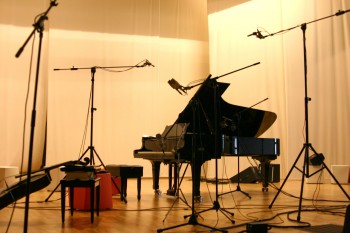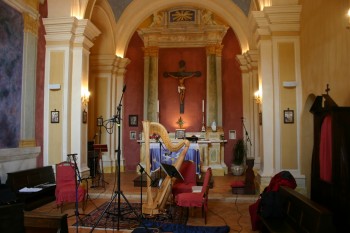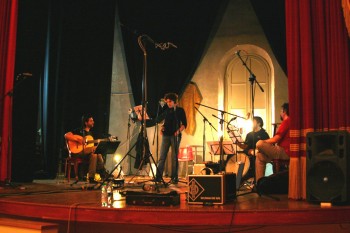R.E.S. Ricostruzione Evento Sonoro – Reconstruction Of The Sound Event
Note sui metodi della ripresa e della “Ricostruzione dell’Evento Sonoro” (R.E.S.)
La “RICOSTRUZIONE DELL’EVENTO SONORO” (R.E.S.), in tutte le sue componenti, timbrica ambientale, dinamica, è il traguardo ultimo di qualunque sistema HI.FI.
Con la definizione R.E.S. ho voluto semplicemente focalizzare l’obbiettivo e proporre una concreta e facile implementazione dei nostri sistemi stereo domestici per raggiungerla.
Per avvicinarsi al traguardo della R.E.S., è possibile aggiungere ai nostri canali stereo, altre due canali posteriori, per aggiungere una parte del segnale ambienza della sala da concerto. Per le casse aggiunte, normalmente più piccole, è caldamente consigliato sceglierle con un suono omogeneo rispetto a quelle anteriori.
La loro collocazione non è critica, infatti durante l’esperienze accumulate con sistemazioni diverse e disposizioni anche non ottimali, il contributo dato alla ricostruzione finale è sempre stato rilevante e chiaramente migliorativo. Il compito di pilotare questi diffusori può essere svolto da un integrato con sufficiente potenza e qualità, in linea con la qualità delle casse.
La lettura dei supporti a più canali, (normalmente DVA-AUDIO multicanale, SACD multicanale, DTS multicanale) può essere svolta da lettori multistandard di qualità e costo adeguato. Ovviamente, maggiore sarà la qualità di tutti i elementi del sistema posteriore, tanto maggiore sarà la rese finale.
Ma la caratteristica più importante che l’insieme deve avere è quello dell’omogeneità tra componenti anteriori e posteriori: ciò che cerchiamo normalmente in tutti i sistemi stereo. La R.E.S. è legata al giusto equilibrio fra l’emissione dello stereo anteriore e quello posteriore. Questa è facilmente ottenibile regolando il livello frontale secondo la nostra personale esigenza e adeguando conseguentemente quello posteriore, agendo semplicemente sul volume dell’integrato che pilota questi canali.
La ricostruzione sarà raggiunta quando, aggiungendo l’emissione posteriore, avremo la sensazione di essere in uno spazio diverso da quello del nostro ambiente, paragonabile a quello dove è stata fatta la ripresa sonora. Le casse posteriori non si devono udire separatamente da quelle anteriori, ma devono contribuire al risultato complessivo.
Il fronte sonoro, sia costituito da un singolo strumento che da una grande orchestra, deve essere ben saldo davanti a chi ascolta, ma espanso in larghezza e profondità a secondo di come è stato registrato, senza nessuna sensazione di presenze posteriori anomale.
In queste condizioni avremo anche un grande aumento delle informazioni sonore generali, con una solidità e tridimensionalità degli strumenti sconosciuta in un sistema stereo. In sintesi avremo raggiunto una credibile “RICOSTRUZIONE DELL’EVENTO SONORO”.
R.E.S. Reconstruction Of The Sound Event
Notes on the methods of the repeat and the “Reconstruction of the Sound Event” (R.E.S.)
The “RECONSTRUCTION OF THE SOUND EVENT” (R.E.S.), in all its parts, environmental tones, dynamics, is the last aim of any HI FI system. With the definition R.E.S.
I would like to focus on the aim and to propose a real and easy implementation of our home stereo system in order to get to it.
To reach the aim of the R.E.S. it is enough to add to our stereo channels other two back stereo channels that will take to a more “real” reconstruction. For the adding speakers, usually a bit smaller , it is highly suggested to choose them with an homogeneous sound compared to the front ones.
Their position is not critical , in fact during the various experiences with different arrangements not always optimal, the contribution given to the last reconstruction has always been considerable and clearly improvement. The task to pilot these speakers can be carried out by an integrated circuit with enough power and quality in line with the quality of the speakers.
The reader of the multi channels supports ( usually DVA-AUDIO multichannel, SACD multichannel, DTS multichannels) can be carried out by multi standard readers of good quality and cost. As a matter of fact, the higher will be the quality of the elements of the back system, the higher will be the final output.
But the most important characteristic of the whole is the homogeneity between front and back elements: what we usually look for in any stereo system. R.E.S. is connected to the right balance between the emission of the front stereo and the back one. This is easily obtainable by balancing the front level according to our personal need and by adjusting the back one, by only operating on the volume of the integrated system that pilots these channels.
The reconstruction will be achieved when, by adding the back emission, we will have the sensation to be in a space different from our environment, comparable to that one where the sound repeat has been performed. The back speaker cannot be heard separately from the front ones, but they must help in the whole result.
The sound front composed of both a single instrument and a big orchestra , must be strong in front of the hearer but it must be expanded in width and depth depending on how it was recorded, without any sensation of strange back presences.
Under these conditions we will have a great increase of the general sound information, with a solidity and tridimensionality of the instruments unknown in a stereo system. To conclude, we will have achieved a credible “RECONSTRUCTION OF THE SOUND EVENT”.




 D5 Creation
D5 Creation